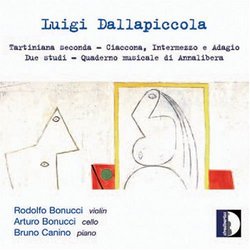| All Artists: Luigi Dallapiccola, Bruno Canino Title: Dallapiccola: Musica da Camera Members Wishing: 0 Total Copies: 0 Label: Stradivarius Release Date: 11/18/1997 Genre: Classical Styles: Chamber Music, Historical Periods, Classical (c.1770-1830) Number of Discs: 1 SwapaCD Credits: 1 UPCs: 723723197924, 8011570333322 |
Search - Luigi Dallapiccola, Bruno Canino :: Dallapiccola: Musica da Camera
 | Luigi Dallapiccola, Bruno Canino Dallapiccola: Musica da Camera Genre: Classical
|
Larger Image |
CD Details |
CD ReviewsAn enjoyable introduction to serialism greg taylor | Portland, Oregon United States | 10/28/2005 (5 out of 5 stars) "Somewhere on Amazon there is a reviewer who expresses skepticism towards anyone who claims to have "gotten" Schoenberg's later works the first time they heard them. I find this skepticism odd for two reasons.
The first reason is a foible I should be used to by now. When will we learn (and I include myself in this) that others are not limited by our own personal limitations? I have enjoyed much twelve-tone or serialist music from the first time I heard it. That doesn't mean I had (or have yet) a good theoretical understanding of it. I think of it as more that I was prepared for the music by being exposed to a lot of classical, jazz and world music at an early age. These thoughts lead me to my second reason which has more to do with Schoenberg's twelve-tone system itself. It seems to me to be a natural development from 19th century music. The pantonality (Schoenberg's own preferred term) of serialism was emerging throughout the 19th and early 20th centuries. Pure tonality was slipping in Chopin and was in full pratfall by the time of Wagner. Debussey, Satie and Scriabin all developed alternatives to it. Try this thought experiment. Let us suppose that we can take several of Shakespeare's most famous soliloquies or sonnets and we take some of the more recognizable lines from them and use them to construct a new sonnet that actually makes sense. Then we read that new sonnet to an audience full of people who know their Shakespeare. Imagine the disorientation as they recognize the first line, remember its context and then are surprised by the second line. As this continues, they realize that what they are hearing makes sense on its own. And they end up having to give up their cultural expectations to try to focus on trying to understand that new sense. In a way, this is what serialism is trying to do (as I understand it). It doesn't embrace dissonance or consonance- it cuts us adrift from what gives those terms meaning and our beloved "resolution". Personally I kind of like it. I think this CD of music by Luigi Dallapiccola will serve as a good introduction for many people to the pleasures of serialism. My brother once described Dallapiccola to me as "Yea, sort of a middle of the road, lyrical serialist". Remove the negative connotations from that description and it is about right. Consider the first piece on this CD, the wonderful "Tartiana seconda". Dallapiccola has created several pieces based themes or phrases of Tartini's. He then manipulates the themes in the standard serialist fashion. The result are pieces that sound very baroque, with a piano parts that sound like something Debussey would create, that are mostly tonal but also slyly dissonant at times. The last movement, "Variations", is particularly strong. This piece is the cause of my whole introductory spiel- you can hear the whole of the nineteenth and some of the twentieth in their development with source material that is baroque. I would claim that this piece is ample proof that serialism is a natural development of the tradition. The second piece,"Due Studi", is more traditionally serialist (the wheel turns and all revolutions become bureaucracies). The first movement is quietly brooding and warns of the aggression to come in the second movement. The final pieces are solos for cello and piano. I could only describe them in the most impressionist of manners so I will suggest only that you listen to the sound samples. The playing by Rodolfo Bonucci (violin), Arturo Bonucci (cello) and Bruno Canino (piano) is wonderful and the recording quality is great. Some of this music in now available on a much cheaper CD on the Naxos label. I am unfamiliar with that recording so I cannot compare them. But I do not hesitate to recommend this CD as an introduction of Dallapiccola and to some of the profound pleasures of serialist music. " |

 Track Listings (20) - Disc #1
Track Listings (20) - Disc #1